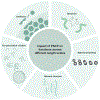A conceptual framework for understanding phase separation and addressing open questions and challenges
- PMID: 35675815
- PMCID: PMC9233049
- DOI: 10.1016/j.molcel.2022.05.018
A conceptual framework for understanding phase separation and addressing open questions and challenges
Abstract
Macromolecular phase separation is being recognized for its potential importance and relevance as a driver of spatial organization within cells. Here, we describe a framework based on synergies between networking (percolation or gelation) and density (phase separation) transitions. Accordingly, the phase transitions in question are referred to as phase separation coupled to percolation (PSCP). The condensates that result from PSCP are viscoelastic network fluids. Such systems have sequence-, composition-, and topology-specific internal network structures that give rise to time-dependent interplays between viscous and elastic properties. Unlike pure phase separation, the process of PSCP gives rise to sequence-, chemistry-, and structure-specific distributions of clusters that can form at concentrations that lie well below the threshold concentration for phase separation. PSCP, influenced by specific versus solubility-determining interactions, also provides a bridge between different observations and helps answer questions and address challenges that have arisen regarding the role of macromolecular phase separation in biology.
Keywords: associative polymers; biomolecular condensate; biophysics; cell biology; cluster; membraneless organelle; network fluid; percolation; phase separation; saturation concentration; viscoelasticity.
Copyright © 2022 Elsevier Inc. All rights reserved.
Conflict of interest statement
Declaration of interests T.M. is a consultant for Faze Therapeutics. She is also a member of the editorial advisory board of Molecular Cell. R.V.P. is a member of the Scientific Advisory Board of Dewpoint Therapeutics Inc. The authors declare that these affiliations have not influenced or compromised the perspective provided here.
Figures




References
-
- Agudo-Canalejo J, Schultz SW, Chino H, Migliano SM, Saito C, Koyama-Honda I, Stenmark H, Brech A, May AI, Mizushima N, et al. (2021). Wetting regulates autophagy of phase-separated compartments and the cytosol. Nature 591, 142–146. - PubMed
-
- Alexov E, and Honig B (2010). Chapter 2 - Structural and Energetic Basis of Molecular Recognition. In Handbook of Cell Signaling (Second Edition), Bradshaw RA, and Dennis EA, eds. (San Diego: Academic Press; ), pp. 11–13.
Publication types
Grants and funding
LinkOut - more resources
Full Text Sources
Other Literature Sources

